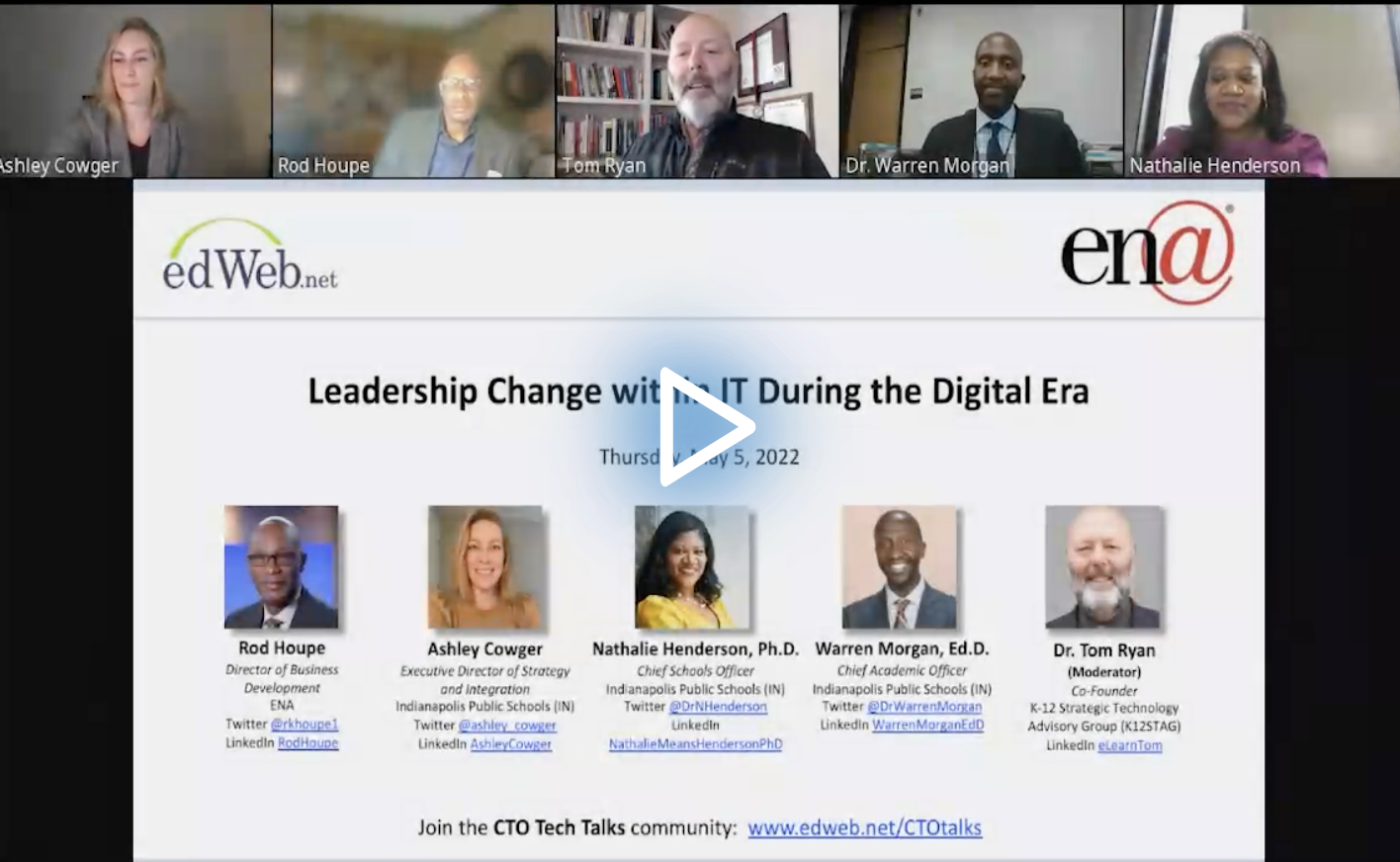Continuing the Development of District Educational Technologies
Watch the Recording Listen to the Podcast
As plans for the next school year are being developed and finalized, the role and management of educational technologies remain key considerations, even with the return to on-site learning.
Ways to optimize school districts’ evolving use of edtech systems, based in part on lessons learned during the pandemic, were discussed during the edLeader Panel, “Leadership Change within IT During the Digital Era.”
Adapting to Hyper Change
When the pandemic began to change everything in March of 2020, Dr. Nathalie Henderson, Chief Schools Officer for Indianapolis Public Schools (IN), had just started working in her new position a few weeks earlier.
The district’s 27,000 students had previously been attending schools that had autonomous computer systems, so there was limited central office support available for the switch to online learning, and some households with children at multiple schools suddenly had a number of different platforms and software systems they needed to manage from home.
In addition to distributing computers for the remainder of the school year and preparing 27,000 learning packets every four weeks, Dr. Henderson and her colleagues emphasized the concept of adaptive leadership as a way to help the district staff cope, adjust, and transform what they were doing in response to the pandemic.
Key principles of this approach included a focus on development, emotional intelligence, and character, which were discussed, modeled, and used as a basis for determining how the staff and their students were feeling and dealing with the unprecedented situation.
The onset of the pandemic also coincided with the rollout of a new strategic plan for the district, and the switch was made from autonomous school-based computer systems to a standardized model, anchored by a single learning management system. The same software was used for all K-2 and 3-12 classes, enabling the IT staff to provide districtwide support but creating a lot of change for educators, parents, and students whose lives and work had already been upended.
To facilitate this widespread and fast-paced transformation, an IT advisory committee was formed, and it included principals who could share what they and their teachers were experiencing. The principals also had opportunities to provide feedback about plans for the future, some of which were changed as a result.
In addition, the district established regular principal development meetings, in which principals could learn from each other about how they were pivoting in response to their new circumstances.
Strategic Staff Development
Ashley Cowger, now the executive director of strategy and integration for the district, was the director of professional learning when the pandemic began, so one of her first challenges was supporting the staff as they switched to the use of remote technologies to provide instruction.
She then had to help teachers with the switch to the new districtwide learning management system and soon began working with the IT staff to develop project plans, establish new priorities, and create “sprints” to accomplish their objectives.
In the years since, the IT team’s “high-intensity routines haven’t let up,” but the team now has a strategic plan, which makes it easier for them to respond to crises and deal with temporary pop-up projects, after which they can return to their longer-term plan. Cowger found that one important cause of stress early in the pandemic was not having a plan, and now the staff is better able to accept new challenges and stabilize afterward.
In order to continue the district’s technological transformation, she believes that collecting feedback to inform the decision-making process is crucial. This includes hearing the voices of principals, teachers, students, and parents, and making sure the IT staff understands where disruptions may occur and what the negative impact will be. There are now processes in place for meeting with teachers before systemwide changes, and for requesting a review prior to the implementation of changes that have raised concerns.
Rod Houpe, Director of Business Development for ENA, also sees an inclusive approach as a key aspect of the decision-making process. This includes speaking “English rather than tech talk,” building trust through information sharing, and working together to figure out how to resolve an issue in a positive manner. In this way, the IT department can become “the department of ‘Know,’ not the department of ‘No.’”
Preparing for the Future
To manage the ongoing process of technological change, such as updating computer networks and programs, the district now has separate hardware and software teams, as well as cross-functional meetings that bring together leaders from different departments such as academics and finance. This provides a more holistic perspective on issues such as vendor specifications, interoperability, and potential duplication.
The last point can be crucial in regard to fiscal responsibility, as Cowger estimates that the switch to a standardized and cost-effective system has saved the district millions of dollars, helping to sustain additional investments in educational technology. Meanwhile, there also is increased monitoring of systems in regard to platform use, data management, and student achievement, to ensure that the district’s funds are being well spent.
Another key aspect of the transformation process, both from an operations and a finance perspective, is cybersecurity. As Cowger put it, “Everybody owns cybersecurity, not solely IT.” One of the biggest risks in that regard is how the staff handles their emails. In her view, building awareness is a crucial part of keeping the district computer networks safe, efficient, and working well for the students, educators, and other district stakeholders.
Learn more about this edWeb broadcast, “Leadership Change within IT During the Digital Era,” sponsored by ENA.
Watch the Recording Listen to the Podcast
Join the Community
CTO Tech Talks is a professional learning community where technology leaders can gather together to share and explore best practices, challenges, and successes in advancing learning with technology.
ENA delivers transformative technology solutions supported by exceptional customer care. We work with our customers to engineer high-capacity and future-ready connectivity, communication, cloud, security, and data analytics solutions to education institutions and libraries across the nation.
Blog post by Robert Low based on this edLeader Panel






Comments are closed.